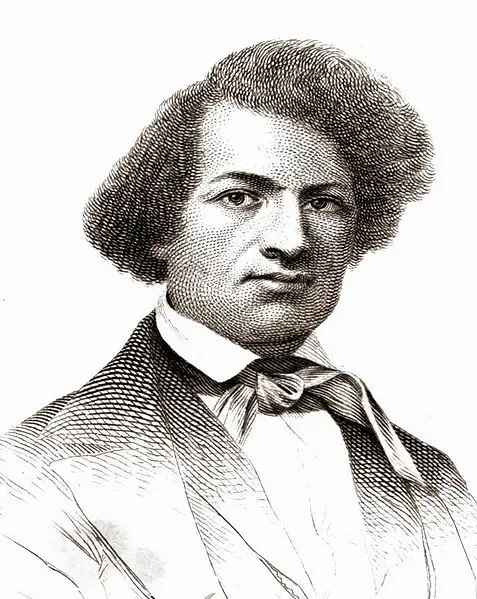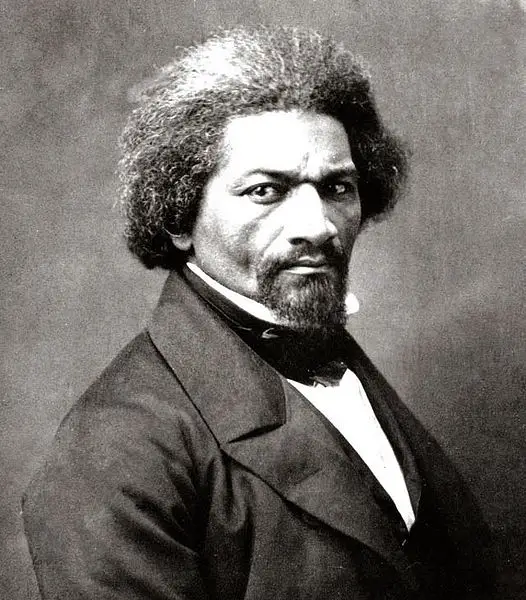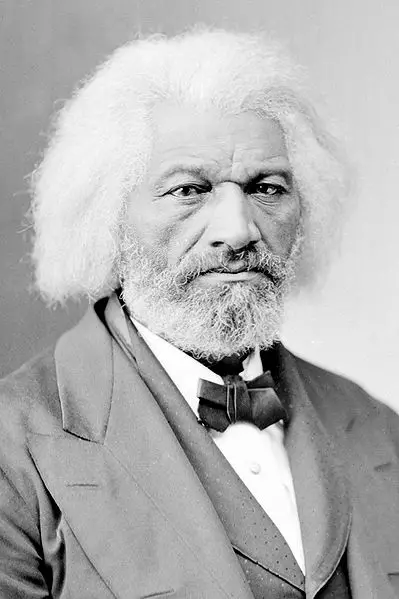The following is a timeline of the life of Frederick Douglass:
1818:
In February of 1812, Frederick Augustus Washington Bailey, is born to Harriet Bailey and an unknown white man, rumored to be his master Aaron Anthony, at Holme Hill Farm in Tuckahoe, Maryland. He has three older siblings, Perry, Sarah, and Eliza.
1820:
In 1820, Kitty Bailey is born to Harriet Bailey in Tuckahoe, Talbot County, Maryland.
1822:
In 1822, Arianna Bailey is born to Harriet Bailey in Tuckahoe, Talbot County, Maryland.
1824:
In August of 1824, Frederick Bailey is sent to Lloyd Plantation, on the Wye River, where he lives with his siblings Perry, Sarah, and Eliza.
1825:
In February of 1825, Frederick’s mother visits him for the last time.
In August of 1825, Frederick’s Aunt Jenny and Uncle Noah successfully escape, making Frederick realize for the first time that escape is possible.
1826:
In late 1825 or early 1826, Frederick’s mother, Harriet Bailey, dies.
In March of 1826, Frederick Bailey is sent to Baltimore to live with Hugh Auld and his wife Sophia.
On November 14, 1826, Frederick’s master, Aaron Anthony, dies.
1827:
In October of 1827, Frederick Bailey becomes the property of Thomas Auld, Anthony’s son-in-law, who returns him to Hugh Auld.
In 1827, Sophia Auld teaches Frederick Bailey to read, but Hugh finds out and puts a stop to it, arguing that education makes slaves rebellious.
1829:
In 1829, Frederick Bailey begins working as a general assistant in a shipyard while continuing to practice reading and writing in secret.
1831:
In 1831, Frederick Bailey reads a newspaper article about John Quincy Adams’s anti-slavery petitions in Congress, thus Frederick learns of the abolitionist movement.
1832:
On July 18, 1832, Frederick’s sister, Sarah, is sold to Perry Cohee of Mississippi.
1833:
In March of 1833, Frederick Bailey is sent to St. Michael’s, Maryland to work for Thomas Auld. There he tries to teach other slaves how to read until Auld discovers what he is doing and stops him.
1834:
On January 1, 1834, Auld rents Frederick Bailey out to a farmer named Edward Covey, who is known as a “slave breaker.” Covey whips Frederick several times.
In August of 1834, Frederick Bailey fights Covey. Frederick is never whipped again.
1835:
On January 1, 1835, Frederick Bailey is reassigned as a field hand to William Freeland.
1836:
On April 2, 1836, an escape plot by Frederick Bailey and several others is foiled. Frederick and the others are jailed in Easton, Maryland.
In April of 1836, Frederick Bailey is sent back to Baltimore by Thomas Auld.
1836-1838:
Between the years 1836-38, Frederick Bailey learns caulking trade, joins a debating society, and also meets Anna Murray, a free black woman from Denton, Maryland.
1838:
On September 3, 1838, Frederick Bailey escapes north by train and boat.
On September 15, 1838, Frederick Bailey marries Anna Murray in New York City.
On September 17, 1838, Frederick and Anna leave New York City for New Bedford, Massachusetts where Frederick finds works as a caulker.
On September 18, 1838, Frederick and Anna arrive in New Bedford, Massachusetts. Frederick changes his last named to Douglass shortly after.
1839:
In 1839, Frederick Douglass first hears William Lloyd Garrison, Wendell Phillips and other abolitionists speak.
On March 12, 1839, Frederick Douglass speaks at a anti-colonization meeting of black citizens of New Bedford and praises praises William Lloyd Garrison and his newspaper The Liberator.
On June 24, 1839, Rosetta Douglass is born to Frederick and Anna Douglass in New Bedford, Massachusetts.
1840:
On October 9, 1840, Lewis Henry Douglass is born to Frederick and Anna Douglass in New Bedford, Massachusetts.
1841:
On June 30, 1841, Frederick Douglass serves as the chairman at a meeting of New Bedford black citizens that condemns Maryland colonization society.
On August 9, 1841, William Lloyd Garrison hears Frederick speak at a New Bedford antislavery meeting and impressed with his public speaking skills.
On August 12-13, 1841, Frederick Douglass speaks three times at the Nantucket convention and is so well received that he is hired as lecturer by Massachusetts Anti- Slavery Society for three-month trail period.
On September 28, 1841, Frederick Douglass is forcibly ejected from a train on the Eastern Railroad for refusing to ride in the segregated car.
In autumn of 1841, the Douglass family moves from New Bedford to Lynn, Massachusetts.
In October of 1841, Frederick Douglass attacks slavery in the South and racial prejudice in the North during a speech in Lynn.
1842:
In January of 1842, Frederick Douglass is hired permanently as an anti-slavery lecturer.
On March 3, 1842, Frederick Douglass Jr is born to Frederick and Anna Douglass in Lynn, Massachusetts.
1843:
On September 16, 1843, Frederick Douglass is attacked by a pro-slavery mob at Pendleton, Indiana.
1844:
On October 21, 1844, Charles Remond Douglass is born toe Frederick and Anna Douglass in Lynn, Massachusetts.

Illustration of Frederick Douglass from 1845
1845:
On May 28, 1845, a Narrative of the Life of Frederick Douglass is published.
On August 6, 1845, Frederick Douglass sails for England, partly to avoid being captured by his owner and partly to spread the antislavery cause in the British isles. He travels on board a Cunard Steamship Company ship called the Cambria.
On August 27, 1845, some of the passengers of the Cambria threaten to throw Frederick Douglass overboard when he attempts to deliver an abolitionist speech.
On August 28, 1845, Frederick Douglass arrives at Liverpool.
On August 31, 1845, Frederick Douglass travels to Dublin, Ireland, for a three-month speaking tour at Dublin, Cork, Limerick and Belfast.
In late September of 1845, a Narrative of the Life of Frederick Douglass is published in Dublin.
On October 25, 1845, Thomas Auld sells ownership of Frederick Douglass to his brother Hugh Auld for $100.
1846:
On October 6, 1846, Frederick Douglass is able to purchase his freedom from Hugh Auld for £150, raised by his British supporters.
On December 12, 1846, Frederick Douglass is officially free after his manumission papers are filed in Baltimore County court.
1847:
On April 20, 1847, Frederick Douglass arrives back in Boston after an 18-month-tour.
In September of 1847, Frederick Douglass announces plans to start a newspaper, The North Star, with funds provided from his British supporters.
In December of 1847, Frederick Douglass moves his family to Rochester, NY.
On December 3, 1847, the first issues of The North Star is published in Rochester, NY.
In December of 1847, Frederick Douglass meets John Brown in Springfield, Massachusetts.
1848:
On July 19-20, 1848, Frederick attends the first Women’s Rights Convention at Seneca Falls, New York.
On September 3, 1848, Frederick publishes an open letter to his former owner, Thomas Auld, in The North Star accusing him of abandoning his grandmother Betsey Bailey in her old age.
1849:
On March 22, 1849, Annie Douglass is born to Frederick and Anna Douglass in Rochester, NY.
On May 5, 1849, Frederick is attacked by a gang of young men while walking along the battery in New York City with two British friends, Julia and Eliza Griffiths.
On September 3, 1849, Frederick Douglass publishes a letter to Auld, his former master, on the eleventh anniversary of his escape from slavery after learning Auld had taken Betsey into his home where she is cared for until her death in November, 1849.
1850:
On April 5, 1850, Frederick Douglass speaks at an anti-Fugitive Slave Bill meeting in Rochester, NY.
1851:
On May 9, 1851, Frederick Douglass has a falling out with Garrison over political actions to end slavery and the two become enemies.
On June 26, 1851,Frederick Douglass changes the name of his newspaper from The North Star to the Frederick Douglass’ Paper and accepts funds from a wealthy anti-Garrisonian political activist named Garrit Smith.
In September of 1851, Frederick helps three fugitive Maryland slaves escape to Canada after they were wanted for murdering their former master when he tried to recapture them in Pennsylvania.
1852:
On July 5, 1852, Frederick Douglass delivers his famous speech, “What to the Slave is the Fourth of July?”, at Corinthian Hall in Rochester, NY.
On September 30, 1852, Frederick Douglass attends the Liberty party Convention at Syracuse where he is chosen as the new Vice-President.
1853:
In February of 1853, Frederick Douglass visits Harriet Beecher Stowe at her home in Hartford, CT.
1855:
In August of 1855, Frederick Douglass publishes his second autobiography, My Bondage My Freedom.
On September 12, 1855, Frederick Douglass attends the Liberty Party Convention at Ithaca, NY, where he becomes the first African American to be nominated for the office of Secretary of States of New York.
1857:
On May 11, 1857, Frederick Douglass delivers a lecture on “The Dred Scott Decision” before the American Anti-Slavery Society in New York.
1858:
On February 1, 1858, John Brown stays at Douglass’ home in Rochester, NY.
1859:
On August 20, 1859, Frederick Douglass secretly meets John Brown at a stone quarry near Chambersburg, PA, where Brown informs him of his planned raid and asks him to join. Frederick refuses.
On October 7, 1859, Frederick Douglass delivers a lecture on “Self-Made Men” in Philadelphia which is interrupted by news of John Brown’s raid on Harper’s Ferry. The following week, Frederick flees to Canada to avoid arrest on suspicion of being Brown’s accomplice.
In November of 1859, Frederick Douglass sails for England where he stays for six months.
On December 2, 1859, John Brown is hanged in Charlestown, Virginia.
1860:
On March 13, 1860, Frederick and Anna’s daughter, Annie Douglass, dies.
In May of 1860, Frederick Douglass returns to the United States after hearing about the death of his daughter.
On August 29, 1860, Frederick Douglass attends an abolitionism convention in Syracuse, NY and is chosen as one of two presidential electors-at-large.
On December 3, 1860, at a meeting to commemorate the anniversary of John Brown’s execution, Frederick is attacked by a mob of Irish laborers and thrown down the stairs.
1861:
In April of 1861, Frederick Douglass calls for black troops to be allowed to fight in Union army.
1862:
On December 31, 1862, Frederick Douglass attends a gathering at Tremont Temple in Boston to celebrate the Emancipation Proclamation, which becomes effective at midnight.
1863:
In February of 1863, Frederick Douglass becomes an agent for the U.S. government to recruit black soldiers into the Union army.
From February – July, Frederick Douglass travels throughout the north recruiting black troops. His sons Lewis and Charles are some of the first to enlist. They join the 54th Massachusetts Regiment.
In July of 1863, Frederick Douglass visits Abraham Lincoln at the White House to speak to him about discrimination against black troops. He also visits Secretary if War ?? Stanton who assures him he will receive a commission in Union Army to recruit black soldiers in the South.
On August 10, 1863, Frederick Douglass receives a pass from Lincoln that enables him to safely pass through the Union lines.
On August 16, 1863, Frederick Douglass ceases publication of Douglass’ Monthly, successor to The North Star and Frederick Douglass’ Papers.
1864:
On August 25, 1864, Frederick Douglass is called to the White House to advise Lincoln on problems in his reelection campaign. He endorses Lincoln for president.
On November 17, 1864, Frederick Douglass visits Maryland for the first time in 26 years to deliver six lectures in Baltimore. During his visit he is reunited with his sister Eliza.
1865:
On March 4, 1865, Frederick Douglass attends Lincoln’s second inauguration and is personally greeted by the President at the Inauguration Ball.
In April of 1865, Frederick Douglass speaks at the annual meeting of the Massachusetts Anti-Slavery Society in Boston on “What the Black Man Wants.”
On April 15, 1865, Frederick Douglass speaks at a memorial meeting in Rochester, NY on the day Lincoln died.
On May 30, 1865, Frederick Douglass speaks at a memorial meeting in New York City on the life and death of Abraham Lincoln after the New York Common Council refused to permit African-Americans to participate in Lincoln’s funeral procession when it passed through the city.
In October of 1865, Frederick Douglass delivers a lecture at the inauguration of the Douglass Institute, a school for black children.

Frederick Douglass in 1866
1867:
In July of 1867, Frederick Douglass meets his brother Perry for the first time in 40 years and arranges for him and his family to live in Rochester, NY.
1868:
From August – October of 1868, Frederick Douglass campaigns for Ulysses S. Grant for president.
In May of 1868, Frederick Douglass breaks with feminist leaders when they refuse to support ratification of Fifteenth Amendment unless it includes right to vote for all women as well as black men.
1870:
In January of 1870, Frederick Douglass joins the staff of New National Era as a corresponding editor.
On December 12, 1870, Frederick Douglass buys the Washington-based paper and its printing plant.
1871:
On January 12, 1871, Frederick Douglass is named assistant secretary of commission of inquiry to Santo Domingo.
On January 18 – March 26, 1871, Frederick Douglass tours Santo Domingo and later defends Grant’s proposal to annex Santo Domingo.
1872:
In May of 1872, Frederick Douglass is nominated for Vice-President of the United States on ticket with Victoria C. Woodhull by the Equal Rights Party, but instead campaigns for re-election of Grant.
On June 2, 1872, a fire destroys Frederick Douglass’ home. The cause of the fire is suspected to be arson.
On July 1, 1872, Frederick Douglass moves his family to Washington D.C.
1874:
In March of 1874, Frederick Douglass is named President of Freedman’s Bank.
In September of 1874, Frederick Douglass closes down New National Era after suffering a serious financial loss from the failure of Freedmen’s Bank.
1876:
On April 14, 1876, Frederick Douglass is one of the main speakers at the unveiling of Freedman’s memorial monument to Abraham Lincoln.
1877:
On March 18, 1877, the Senate confirms Frederick Douglass’ appointment as United States Marshal for the District of Columbia.
On June 17, 1877, Frederick Douglass returns to St. Micheal’s for the first time in 41 years where he meets with Thomas Auld and speaks to a racially mixed audience.
1878:
In 1878, Frederick Douglass purchases a 15-acre estate, called Cedar Hill, in Anacostia, D.C.
On November 23-26, 1878, Frederick Douglass visits Easton where he delivers a lecture at the Courthouse and locates the site of his birth on Tuckahoe Creek.
1879:
In June of 1879, a bust of Frederick Douglass is presented to the city of Rochester, NY.

Frederick Douglass in 1880
1881:
In January of 1881, Frederick Douglass publishes his third autobiography, Life and Times of Frederick Douglass, but the book fails to sell.
In March of 1881, Frederick Douglass is appointed by President Garfield as Recorder of Deeds for the District of Columbia.
On June 12, 1881, Frederick Douglass revisits Lloyd Plantation, called Wye House.
1882:
On August 4, 1882, Anna Douglass dies.
1883:
In April of 1882, Frederick Douglass delivers a speech on the 21 anniversary of emancipation in the District of Columbia.
1884:
In January of 1884, Frederick Douglass marries Helen Pitts, a white woman who was once his secretary.
1886:
In January of 1886, Frederick Douglass resigns as as Recorder of Deeds for D.C.
From September of 1886 – August of 1887, Frederick Douglass and Helen Pitts take an extended trip to England, Ireland, France, Switzerland, Italy, Egypt and Greece.
1889:
On July 1, 1889, Frederick Douglass is appointed by President Benjamin Harrison as Minister Resident and Consul General to Haiti.
In September of 1889, Frederick Douglass is appointed Charge’ d’Affaires for Santo Domingo in addition to Minister to Haiti.
1891:
On July 30, 1891, Frederick Douglass resigns as Minister Resident and Consul General to Haiti due to his disapproval of maneuvering by State Department and American business to acquire Mole St. Nicolas.
1892:
In 1892, the revised edition of the Life and Times of Frederick Douglass is published but fails to sell.
On July 26, 1892, Frederick Douglass, Jr, dies.
From 1892-1893, Frederick Douglass serves as the Commissioner of Haitian exhibit at World’s Fair in Chicago.
1893:
In March of 1893, Frederick Douglass announces plan to establish Freedom Manufacturing Company, a textile manufacturing firm, in Norfolk, VA, where he hopes to employ 300 black workers. The plan later proves to be a sham by promoters trying to using Douglass’ name and prestige.
1894:
In January of 1894, Frederick Douglass delivers his last speech, “Lessons of the Hour,” which is about lynching laws in the south.
1895:
On the morning of February 20, 1895, Frederick Douglass attends morning sessions of the National Council of Women in Washington, D.C.
At 7pm on February 20, 1895, Frederick Douglass dies of a massive heart attack at his home at Cedar Hill while awaiting a carriage to take him to Hillside African Church where he was scheduled to speak.
On February 25, 1895, Frederick Douglass’ funeral service is held at Cedar Hill and his body lies in state at Metropolitan African Methodist Church in Washington.
On February 26, 1895, Frederick Douglass lies in state at Rochester City Hall. His funeral service is held in Rochester Central Presbyterian Church, He is later buried in Mount Hope Cemetery, Rochester, NY.
If you want to learn more about Frederick Douglass, check out the following article about the best books about Frederick Douglass.
Sources:
“Death of Fred Douglass.” New York Times, 21 Feb. 1895, archive.nytimes.com/www.nytimes.com/learning/general/onthisday/bday/0207.html
Douglass, Frederick. Narrative of the Life of Frederick Douglass. Boston: Anti-Slavery Office, 1849.
“Frederick Douglass Timeline.” Library of Congress, www.loc.gov/collections/frederick-douglass-papers/articles-and-essays/frederick-douglass-timeline/
“Frederick Douglass Chronology.” NPS.gov, National Park Service, U,S. Department of the Interior, www.nps.gov/frdo/learn/historyculture/frederick-douglass-chronology.htm

